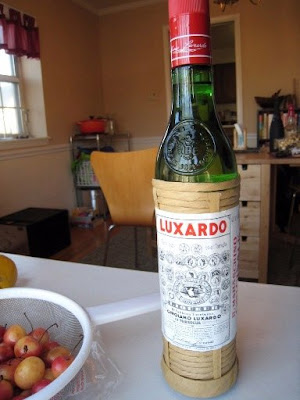One of my new obsessions is classic drinks. I'm convinced that people forgot what drinking was like back in the good old days, the glory days. Well, let's take a quick trip back to the good times. Times like the "Gay Nineties" - the 1890s - when alcohol legends like Jack Daniels, Dewars, and Bacardi were in the process of gaining notoriety, alcohols could be safely transported around the world, and people all over Europe and North America were starting to experiment with classy cocktails without clubbing music and Jaeger bombs trying to horn their way in. Vodka hadn't been introduced to the Western world much, and tequila was just starting to inch its way north and east. This left gin, whiskies, brandies, liqueurs, and all kinds of interesting ingredients for bartenders to formulate various cocktails, often drank as either an aperitif, a morning eye-opener, or even for medicinal reasons. Bartenders even used to place the bottle in front of the patron and let him pour out his own, measuring the results in how many 'fingers' he took and charging accordingly.
Gone are these days for the most part - the days of a well constructed drink, the days of a bartender who took his time and used quality ingredients such as house made bitters and garnishes like Maraschino cherries and cocktail onions, the days when people even knew to ask for these drinks and could tell a well made martini from a thrown together mix of bottom shelf gin, vodka, and a splash of vermouth. Some would say that we lost a lot of this art with Prohibition in the 1920s, but I would argue that we really lost a lot of this over the last 20-30 years, as recreational drugs and flavored alcohols gained in popularity, and drinking became more of a sport or "pre-gaming" necessity than it was a pasttime.
Fortunately for us, bars that do remember these things are making a resurgence. You can find pre-prohibition style bars in major cities all over the place - I've found them in San Francisco, Chicago, Washington, D.C., Austin, and New York City, and that's clearly just scratching the surface. And the home bartender can still find the right ingredients with enough dedicated searching and a helpful liquor store owner. Let me help you start re-exploring old-timey cocktails, in the hopes that maybe you'll take up drinking and mixology as a pasttime, like I'm trying to do.
 |
| Some of the crazy ingredients we're going to learn about |
Martinez
For example, you may never have heard of this one - the Martinez. Widely regarded as the precursor to the Martini, the Martinez is made with a very specific style of gin known as
Old Tom Gin, sweeter than
London Dry Gin such as Bombay, Tanqueray, and Beefeater, but less sweet than
Dutch / Holland / Jenever Gin like the original product of Ketel One and a product sold by Bols, although odds are you've never tried either of those. Anyway, there are a few stories about the name Martinez, but I like the version that goes that the drink was invented in San Francisco by "Professor" Jerry Thomas (who also invented the Blue Blazer, claimed to invent the Tom and Jerry, and helped popularize the hoax that led to the spread of the Tom Collins) for a traveler en route to Martinez, CA. There are a few recipes for this floating around, mostly differing in their ratios, but I will post the one I made last night, which reminded me of the first one I had, and which I think is perfectly balanced - sweet, yet drying.
 |
| The Martinez, a slightly sweeter predecessor to the Martini, but oh so delicious and strangely dry afterwards |
First, we'd better start with the ingredient list. Odds are that you haven't had (or heard of) any of the four ingredients before. Excited yet? You should be, because these might change your life, or at least how you think about mixed drinks. First, the gin. You need a good Old Tom gin, so why not go for the grandfather of them, all, Hayman's. Next, the vermouth, which, unlike a Martini, uses Italian-style, or sweet vermouth. But not just any sweet vermouth - Carpano Antica, made by the company who claims to have invented vermouth. This vermouth has notes of cocoa, cinnamon, licorice, orange peel, and tons of other complex flavors, and is so good you can drink it on its own. I would not skimp on this, and would search it out - it comes in a metal can with the bottle inside, and is disgustingly overpriced for a vermouth, although well worth it. Next, you need a Maraschino liqueur, notably Luxardo. This is what
real maraschino cherries used to be made with, and it is made with Marasca cherries and cherry pits, providing almost an almond-like flavor that's also incredible on its own. Finally, orange bitters go in this - arguably the easiest of the four ingredients to find, as bitters have made the biggest resurgence of all pre-prohibition components these days. I used Regan's, which is fairly easy to find. So now, the actual recipe and process:
- 1.5 oz Old Tom gin, such as Hayman's
- 1.5 oz sweet vermouth, ideally Carpano Antica
- 2 tsp Maraschino liqueur, such as Luxardo
- 2 dashes (1/3 tsp) orange bitters, such as Regan's
- Ice
- Twist of lemon
- Maraschino cherries (my homemade recipe here)
 |
| A good close-up of our ingredient set, minus the cherries |
Okay, process is important here. To start, get out a Martini glass, and fill it with whole ice cubes to chill it. Meanwhile, fill a large shaker with whole ice cubes. Add the gin, vermouth, Maraschino, and bitters, and stir (do NOT shake) vigorously to chill. You may note that I gave an actual measure for 2 dashes - that's because it actually has a volume! There are 6 dashes in a teaspoon by official convention. Want to know how much you're pouring? Pour a teaspoon of water into a dish, and then shake out an equivalent amount of bitters into an identical dish. Did it take 6 of your dashes? Probably not. So figure out what a 'dash' actually requires by your hand, and stick to it. Shaking a bottle over your drink and hoping for magic just isn't going to work here; use the scientific method, come on. Where did I learn this? From David Embury's The Fine Art of Mixing Drinks, widely considered to be the bible of mixology, and written in 1948.
Anyway, we should finish the drink. Dump the ice out of the Martini glass. Use a drink strainer to pour the drink into the glass, and twist the lemon peel over. Garnish with one or two cherries, and enjoy!
Old Fashioned
Moving on, let's consider the Old Fashioned, which is much more well known. I gather that this was popular on the show Mad Men, but can't confirm. The Old Fashioned is a bourbon-based drink with some great ingredients, which are also much easier to find. There's nothing crazy about this one, although it can lay you out if you don't take it seriously. You'll also need a rocks glass or an Old-Fashioned glass, which is very different from a cocktail or Martini glass.
- 2 oz bourbon
- 2 tsp simple syrup (2:1 sugar:water, heated up to dissolve the sugar and then cooled)
- 2 dashes aromatic bitters, such as Angostura
- Slice of orange
- Ice
- Twist of orange
- Maraschino cherry (again, homemade recipe here. Don't buy the terrible bright red ones, please)
Put the simple syrup and bitters at the bottom of an empty Old Fashioned glass, and stir with a spoon to combine. You could alternatively muddle a sugar cube with the bitters, or try to dissolve the cube in warm water, then pour off the water, then muddle, but I prefer the easy method of the syrup. Now add the bourbon and stir. Put in the orange slice, and add cracked (not crushed) ice cubes to the glass. Garnish with a twist of orange and a Maraschino cherry. I like
Esquire's write-up that says not to muddle fruit into the drink, which apparently was done during Prohibition to mask the taste of bad booze with sweet fruit, and which takes away from the purity of this drink.
 |
| A few Old-Fashioneds, without too much muddled fruit to ruin the clean taste of this drink |
That's it for now, but hopefully you can try these out and get some Maraschino cherries ready while you wait for more drink recipes!






































